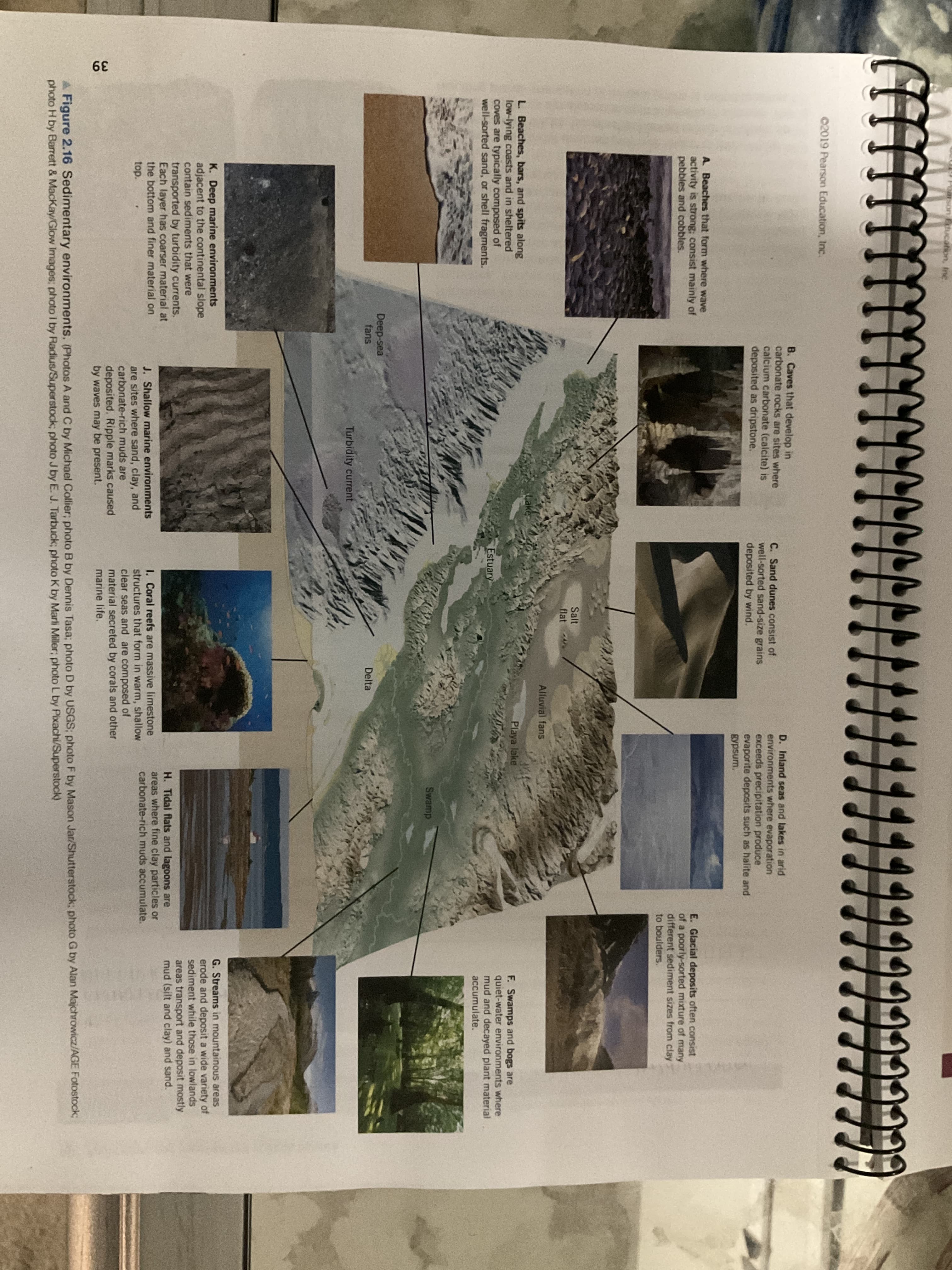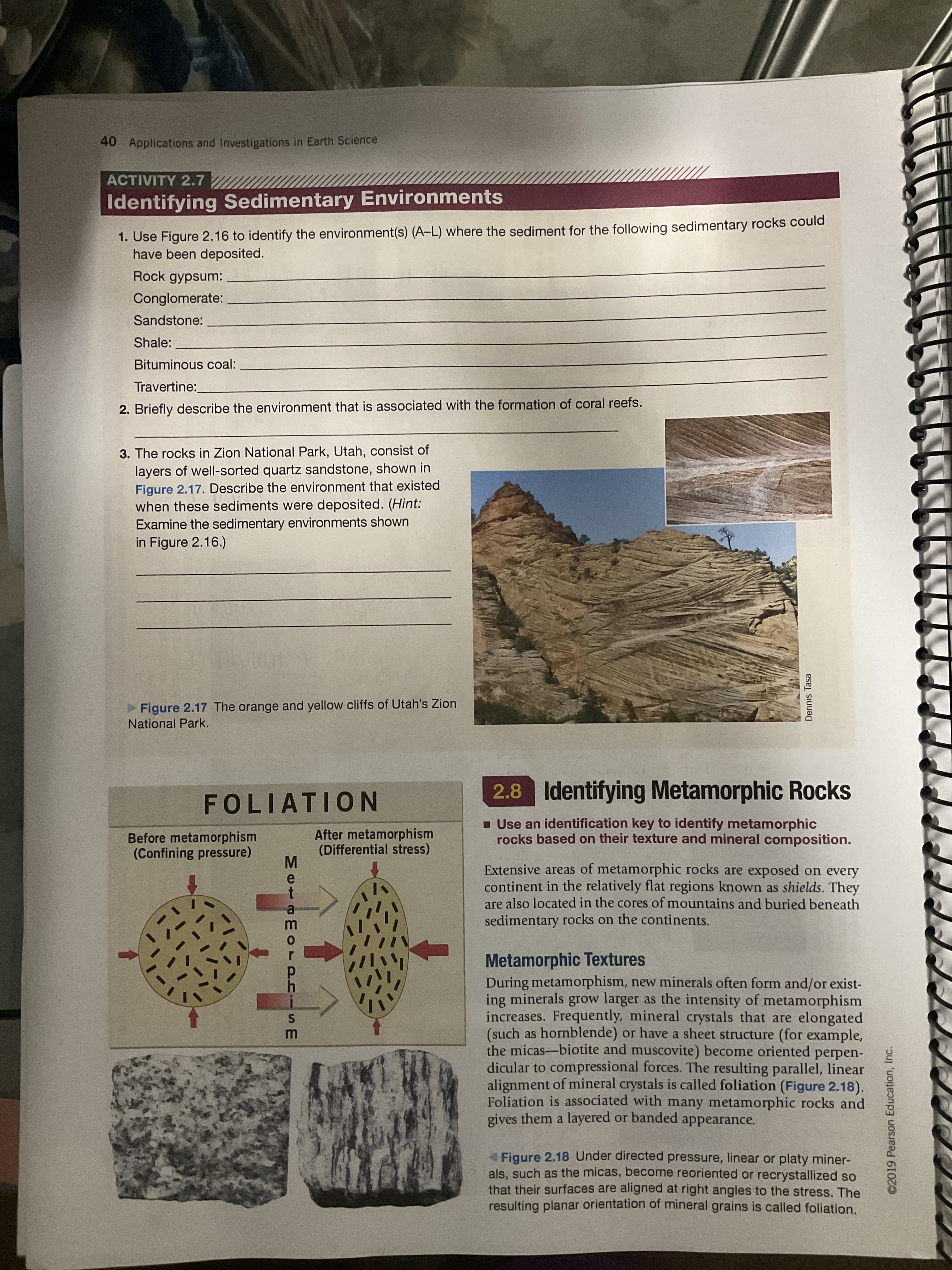1. Use Figure 2.16 to identify the environment(s) (A-L) where the sediment for the following sedimentary rocks could have been deposited. Rock gypsum: Conglomerate: Sandstone: Shale: Bituminous coal: Travertine: the formotion of coral reefs
1. Use Figure 2.16 to identify the environment(s) (A-L) where the sediment for the following sedimentary rocks could have been deposited. Rock gypsum: Conglomerate: Sandstone: Shale: Bituminous coal: Travertine: the formotion of coral reefs
Applications and Investigations in Earth Science (9th Edition)
9th Edition
ISBN:9780134746241
Author:Edward J. Tarbuck, Frederick K. Lutgens, Dennis G. Tasa
Publisher:Edward J. Tarbuck, Frederick K. Lutgens, Dennis G. Tasa
Chapter1: The Study Of Minerals
Section: Chapter Questions
Problem 1LR
Related questions
Question
Question in the picture

Transcribed Image Text:.ndg uose
(f
02019 Pearson Education, Inc.
B. Caves that develop in
carbonate rocks are sites where
calcium carbonate (calcite) is
deposited as dripstone.
C. Sand dunes consist of
well-sorted sand-size grains
deposited by wind.
D. Inland seas and lakes in arid
environments where evaporation
exceeds precipitation produce
evaporite deposits such as halite and
gypsum.
A. Beaches that form where wave
activity is strong; consist mainly of
pebbles and cobbles.
E. Glacial deposits often consist
of a poorly-sorted mixture of many
different sediment sizes from clay
to boulders.
Salt
flat
Alluvial fans
Lake
L Beaches, bars, and spits along
low-lying coasts and in sheltered
coves are typically composed of
well-sorted sand, or shell fragments.
Playa lake
F. Swamps and bogs are
quiet-water environments where
mud and decayed plant material
accumulate.
Estuary
Swamp
Deep-sea
fans
Delta
Turbidity current
K. Deep marine environments
adjacent to the continental slope
contain sediments that were
G. Streams in mountainous areas
erode and deposit a wide variety of
sediment while those in lowlands
areas transport and deposit mostly
mud (silt and clay) and sand.
transported by turbidity currents.
Each layer has coarser material at
the bottom and finer material on
H. Tidal flats and lagoons are
areas where fine clay particles or
carbonate-rich muds accumulate.
J. Shallow marine environments
are sites where sand, clay, and
carbonate-rich muds are
deposited. Ripple marks caused
by waves may be present.
1. Coral reefs are massive limestone
structures that form in warm, shallow
clear seas and are composed of
material secreted by corals and other
marine life.
top.
A Figure 2.16 Sedimentary environments. (Photos A and C by Michael Collier; photo B by Dennis Tasa; photo D by USGS; photo F by Mason Jar/Shutterstock; photo G by Alan Majchrowicz/AGE Fotostock3B
photo H by Barrett & MacKay/Glow Images: photo I by Radius/Superstock; photo J by E. J. Tarbuck; photo K by Marli Miller; photo L by Pixachi/Superstock)
39

Transcribed Image Text:Matam OTPriE
Dennis Tasa
©2019 Pearson Education, Inc.
40 Applications and Investigations in Earth Science
ACTIVITY 2.7
Identifying Sedimentary Environments
1. Use Figure 2.16 to identify the environment(s) (A-L) where the sediment for the following sedimentary rocks could
have been deposited.
Rock gypsum:
Conglomerate:
Sandstone:
Shale:
Bituminous coal:
Travertine:
2. Briefly describe the environment that is associated with the formation of coral reefs.
3. The rocks in Zion National Park, Utah, consist of
layers of well-sorted quartz sandstone, shown in
Figure 2.17. Describe the environment that existed
when these sediments were deposited. (Hint:
Examine the sedimentary environments shown
in Figure 2.16.)
Figure 2.17 The orange and yellow cliffs of Utah's Zion
National Park.
FOLIATION
2.8 Identifying Metamorphic Rocks
Before metamorphism
(Confining pressure)
After metamorphism
(Differential stress)
- Use an identification key to identify metamorphic
rocks based on their texture and mineral composition.
Extensive areas of metamorphic rocks are exposed on every
continent in the relatively flat regions known as shields. They
are also located in the cores of mountains and buried beneath
sedimentary rocks on the continents.
Metamorphic Textures
During metamorphism, new minerals often form and/or exist-
ing minerals grow larger as the intensity of metamorphism
increases. Frequently, mineral crystals that are elongated
(such as hornblende) or have a sheet structure (for example,
the micas-biotite and muscovite) become oriented perpen-
dicular to compressional forces. The resulting parallel, linear
alignment of mineral crystals is called foliation (Figure 2.18).
Foliation is associated with many metamorphic rocks and
gives them a layered or banded appearance.
Figure 2.18 Under directed pressure, linear or platy miner-
als, such as the micas, become reoriented or recrystallized so
that their surfaces are aligned at right angles to the stress. The
resulting planar orientation of mineral grains is called foliation.
Expert Solution
Step 1
“Since you have asked multiple questions, we will solve the first question for you. If you want any specific question to be solved, please specify the question number or post only that question.”
The weathering agents like air, water, glaciers, etc., have the ability to erode rocks, transport the eroded material, and at last, drop these, which is called sedimentation. Later, due to compaction, these sediments solidify to become rocks, called sedimentary rocks. There is a wide variety of sedimentary rocks. From the sedimentary rocks, we can identify their forming environment.
Trending now
This is a popular solution!
Step by step
Solved in 2 steps

Recommended textbooks for you

Applications and Investigations in Earth Science …
Earth Science
ISBN:
9780134746241
Author:
Edward J. Tarbuck, Frederick K. Lutgens, Dennis G. Tasa
Publisher:
PEARSON

Exercises for Weather & Climate (9th Edition)
Earth Science
ISBN:
9780134041360
Author:
Greg Carbone
Publisher:
PEARSON

Environmental Science
Earth Science
ISBN:
9781260153125
Author:
William P Cunningham Prof., Mary Ann Cunningham Professor
Publisher:
McGraw-Hill Education

Applications and Investigations in Earth Science …
Earth Science
ISBN:
9780134746241
Author:
Edward J. Tarbuck, Frederick K. Lutgens, Dennis G. Tasa
Publisher:
PEARSON

Exercises for Weather & Climate (9th Edition)
Earth Science
ISBN:
9780134041360
Author:
Greg Carbone
Publisher:
PEARSON

Environmental Science
Earth Science
ISBN:
9781260153125
Author:
William P Cunningham Prof., Mary Ann Cunningham Professor
Publisher:
McGraw-Hill Education

Earth Science (15th Edition)
Earth Science
ISBN:
9780134543536
Author:
Edward J. Tarbuck, Frederick K. Lutgens, Dennis G. Tasa
Publisher:
PEARSON

Environmental Science (MindTap Course List)
Earth Science
ISBN:
9781337569613
Author:
G. Tyler Miller, Scott Spoolman
Publisher:
Cengage Learning

Physical Geology
Earth Science
ISBN:
9781259916823
Author:
Plummer, Charles C., CARLSON, Diane H., Hammersley, Lisa
Publisher:
Mcgraw-hill Education,